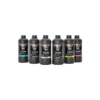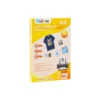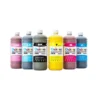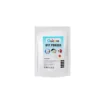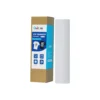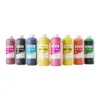No matter how great your design or how vibrant your colors are, if that powder isn’t properly cured, your print simply won’t stick around.
Why You Need To Cure DTF Powder
The value of the presence of powder in the DTF printing process is to give the ink additional potential advantages. These advantages make the print on the substrate according to the characteristics. Whether it is the sense of touch or the sense of sight. It is also because of this layer that the powder is particularly valuable. It is also the backbone of adhesion. dtf powder (also known as hot-melt adhesive powder) is the key to bonding the print to the fabric during hot pressing. Without curing, this powder won’t melt and fuse with the ink, which means your pattern will fall apart or peel off after the first wash.
The powder melts when exposed to heat, usually between 120°C and 130°C, and forms a tacky layer. Subsequent heat press transfers are made where the cured film is bonded to the garment, handbag or cap by heat pressing.
The reason for baking the powder is that the ink on the DTF film needs the powder to provide durability. If the baking powder is not baked at a sufficient temperature, then there is a risk that the film will oil back. A similar reaction occurs when insufficient temperature is applied when the film is pressed with a heat press. See also: What is the DTF Film Oil Return Phenomenon

Types of DTF Powder – Not All Are Created Equal
Before we can talk about curing, you need to choose the right powder. Not every DTF powder works the same, and using it incorrectly can affect the entire process.
Here are the common categories you’ll see:
- Fine Powders: for fine prints and fine threads. Melts fast and is suitable for light fabrics.
- Medium Powder: versatile. Versatile and reliable for both light and dark colored garments.
- Coarse Powder: Best for heavy fabrics such as hoodies or denim. Takes longer to melt, but has good holding power.
Yes, this is important. For example, using coarse powder on a lightweight t-shirt may make the print feel stiff and bulky, whereas using coarse powder on a hoodie is more appropriate for the material and feel of such garments. So choose wisely depending on who you are printing for.
In addition to these three powders, there are also some powders that are special in nature, such as low-temperature powders, where baking and curing can be accomplished at much lower temperatures. This is helpful for mass production.
There are also soft powders, which are softer than regular fine powders. When printing with regular powders, the final substrate is not likely to be more pliable in the patterned areas, and a whole area will have a “hard” feel to it. As shown in the figure below.

Both excessive rigidity and excessive softness can impact the quality of DTF transfers to some extent, especially under stretching tests. A rigid transfer won’t stretch, while a soft one is prone to stretching and cracking. See also: Stretch Cracking Of The Product After DTF Printing.
How To Actually Cure DTF Powder
Let’s focus on just this one critical part—curing the powder—not the entire DTF process. Here’s how you do it right, step by step.
1: Oven Curing
If you’re aiming for more consistent results or scaling up production:
- Preheat the curing oven to 120–140°C.
- Place your film (powder side up) on a tray or mesh rack.
- Cure for 2–3 minutes—until the powder melts and forms a smooth, even layer.
- Let it cool before handling.
This method offers better uniformity and is ideal for batches, but you’ll need space and a bit more investment. See also: How To Cure DTF Powder With Oven?

2: Heat Press Curing
If you’re using a heat press for curing (which many small setups do), here’s the rundown:
- Lay down the film with powder already applied—ink side up—on your heat press base.
- Don’t close the press. Instead, hover the top platen about 1–2 cm above the film.
- Set your press to 180°C (350°F).
- Cure for about 60–120 seconds, keeping an eye on it.
- Look for the matte, slightly textured finish—that’s your sign it’s cured.
Avoid direct contact between the film and press, or the ink might melt or smudge. Swing-away heat presses make this a lot easier than clamshells.
Using a heat press is one way to do this, but I still don’t recommend it. Please see for details: Not Recommend To Cure DTF Powder With Heat Press

3: Shaker Oven Units
These are the dream tools for high-volume setups. You just feed the printed film into the machine, and it handles everything: powdering, curing, and output.
Pros? Time-saving, mess-free, and super consistent.
Cons? Pricey for small businesses or hobbyists.
What Happens If You Skip Curing?
Okay, so what if you don’t cure the powder—or don’t cure it properly? Here’s what you’re in for:
- Peeling Prints: Your artwork lifts off the fabric like a sticker with weak glue.
- Poor Wash Resistance: One wash and it’s game over.
- Sticky Surfaces: Powder that wasn’t melted will stay tacky, pick up lint, or stick to your heat press.
- Color Bleeding: Without proper bonding, ink can shift or smear when pressed.
- Uneven Textures: You’ll see blotches where some powder melted and some didn’t.
- Transfer Ruin: The whole sheet might warp, making it useless.
And worst of all? Customers won’t be happy. And they’ll remember. They may not consider buying the powder you offer or the film someone else offers next time.
The pictures below show us what can happen when DTF powder is not fully cured.

Conclusion
Curing powder is essential for DTF printing, playing a pivotal role throughout the entire process. While you can experiment with various curing methods, it’s crucial to first identify the type of powder you’re using. Different types of powder have varying curing requirements, so avoid using a single, uniform method for all.


